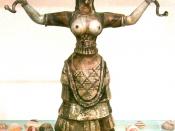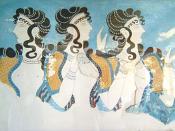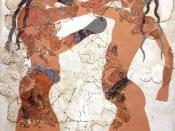With a doctorate in art history, it was no wonder that I would quickly climb the corporate ladder at the elite tour company, Athena Excursions. I have recently taken on the sole responsibility of planning an overseas tour to explore the art of the ancient world. Primarily, we will be looking at works from the Aegean, Greek, Etruscan and Roman periods. We will be examining works that encompass the characteristics of the art from these periods. Despite my desire to present well-known works to our guests, I would like to highlight some more obscure works on our tour to leave the visitors feeling like they got an exclusive look at the works. Initially, I had a particularly substantial medley of works that would be worthy of our trip, however, due to time constraints I have narrowed the collection down to six knowledge-quenching selections.
The Boxing Boys fresco (Figure 1)
Our first destination is a small, Cycladic island in the Aegean Sea known as Santorini, once named Thera.
It is on this island where the Minoan site of Akrotiri has been uncovered. Once the site of a devastating volcanic eruption, many significant works of art have remained preserved beneath the volcanic ash. The frescoes, in particular, are in impeccable shape considering their age.
Selected for its Minoan characteristics, this Boxing Boys fresco (before 1628 B.C.) remains in excellent condition to this day. It is most likely a true fresco. Found at Akrotiri, it reflects many of the Minoan characteristics. The two young boys are engaged in a playful boxing match. Their reddish, exposed skin is characteristic of the Minoan style. The two nude young boys face each other, providing the viewer with a profile perspective of the boys. However, even with profiled faces, they have frontal eyes like the Egyptians. Their...


